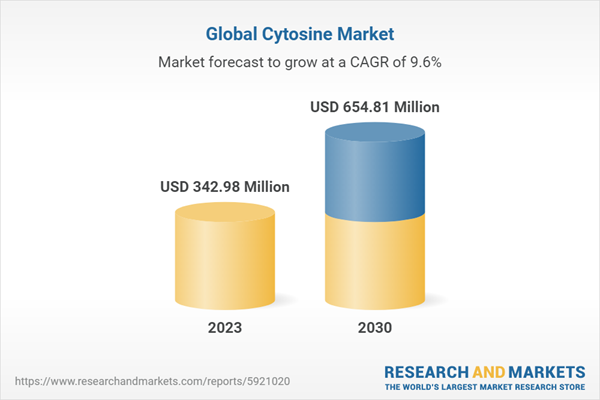The global cytosine market size is estimated to reach USD 654.81 million by 2030, and is expected to grow at a CAGR of 9.6% from 2024 to 2030. This growth is attributed to the extensive product usage in various applications in end-use industries, such as pharmaceuticals, agriculture, and chemicals. The pharmaceutical industry is a major end-user of the market. Cytosine is a nucleotide base, which is utilized in the synthesis of various pharmaceutical products, including antiviral drugs, anticancer agents, and nucleoside analogues. The emphasis on genomics and personalized medicine within the industry has further increased product demand.
Genomic research requires the analysis of DNA sequences, and it is one of the four nucleotide bases that make up DNA. Cytosine's role in genomic sequencing and analysis makes it indispensable for understanding genetic variations and developing targeted therapies. The global industry presents opportunities for R&D to explore new applications and optimize the properties of itself as well as its derivatives. Ongoing research can focus on enhancing the efficacy, bioavailability, and safety profiles of its analogs, leading to improved treatment options for HIV/AIDS patients. In addition, research can explore its potential use in combination therapies and novel drug delivery systems. The product demand as an intermediate has been on the rise, particularly in the field of personalized medicine and genetic testing.
This growing demand can contribute to upward pressure on the prices of cytosine. Versatile nature and utility of the product, as well as rising demand for innovative pharmaceuticals, has led to it being used in intricate processes in drug development directed toward varied ailments and health conditions. The agriculture segment primarily revolves around utilizing other nucleotide bases in agricultural applications. Cytosine plays a crucial role in crop improvement and breeding programs. Genetic variations and mutations in cytosine and other nucleotide bases are essential for traditional crop breeding, allowing the development of improved crop varieties with desirable traits, such as disease resistance, increased yield, and enhanced nutritional content.
Genomic research requires the analysis of DNA sequences, and it is one of the four nucleotide bases that make up DNA. Cytosine's role in genomic sequencing and analysis makes it indispensable for understanding genetic variations and developing targeted therapies. The global industry presents opportunities for R&D to explore new applications and optimize the properties of itself as well as its derivatives. Ongoing research can focus on enhancing the efficacy, bioavailability, and safety profiles of its analogs, leading to improved treatment options for HIV/AIDS patients. In addition, research can explore its potential use in combination therapies and novel drug delivery systems. The product demand as an intermediate has been on the rise, particularly in the field of personalized medicine and genetic testing.
This growing demand can contribute to upward pressure on the prices of cytosine. Versatile nature and utility of the product, as well as rising demand for innovative pharmaceuticals, has led to it being used in intricate processes in drug development directed toward varied ailments and health conditions. The agriculture segment primarily revolves around utilizing other nucleotide bases in agricultural applications. Cytosine plays a crucial role in crop improvement and breeding programs. Genetic variations and mutations in cytosine and other nucleotide bases are essential for traditional crop breeding, allowing the development of improved crop varieties with desirable traits, such as disease resistance, increased yield, and enhanced nutritional content.
Cytosine Market Report Highlights
- Pharmaceuticals will emerge as the fastest-growing end-use segment with a CAGR of 9.8% from 2024 to 2030 due to cytosine’s crucial role in the development of nucleic acid-based therapeutics
- Europe is expected to register the fastest CAGR of 10.3% from 2024 to 2030 due to the presence of well-established end-user industries, such as pharmaceuticals and chemicals
- Cytosine is a fundamental component in plant genomics and molecular biology research. Plant scientists utilize cytosine and other nucleotide bases to study the structure, function, and interactions of plant genes
- The product consumption is subjected to various policies/regulations that need to be followed. Some of the major regulations are Sanitary and Phytosanitary Measures (SPS) Agreement, Intellectual Property Rights (IPR), and Pricing and Reimbursement policies. In some cases, these policies/regulations pose a challenge to industry growth
- Numerous innovations are taking place that revolve around product usage, especially for the synthesis of drugs targeting various ailments
- For example, in January 2023, Cambridge Epigenetix, a UK-based company specializing in DNA sequencing technology, recently underwent rebranding and is now known as Biomodal. As a part of this rebranding, the company has launched a new product that offers a streamlined sequencing workflow capable of capturing both genetic & epigenetic information within DNA
Table of Contents
Chapter 1 Methodology and Scope
Chapter 2 Executive Summary
Chapter 3 Cytosine: Market Variables, Trends & Scope
Chapter 4 Cytosine Market: End-use Estimates & Trend Analysis
Chapter 5 Cytosine Market: Regional Estimates & Trend Analysis
Chapter 6 Competitive Landscape
List of Tables
List of Figures
Companies Mentioned
- Spectrum Chemical
- Tuoxin Pharmaceutical
- VIVAN Life Sciences
- KANTO KAGAKU
- Tokyo Chemical Industry Co., Ltd.
- SIELC Technologies
- Santa Cruz Biotechnology, Inc.
- FUJIFILM Wako Pure Chemical Corporation
Methodology

LOADING...
Table Information
| Report Attribute | Details |
|---|---|
| No. of Pages | 100 |
| Published | December 2023 |
| Forecast Period | 2023 - 2030 |
| Estimated Market Value ( USD | $ 342.98 Million |
| Forecasted Market Value ( USD | $ 654.81 Million |
| Compound Annual Growth Rate | 9.6% |
| Regions Covered | Global |
| No. of Companies Mentioned | 8 |









